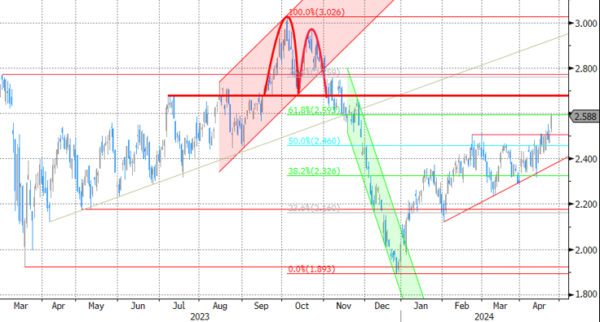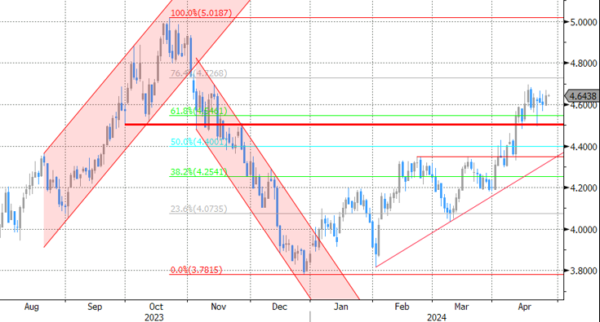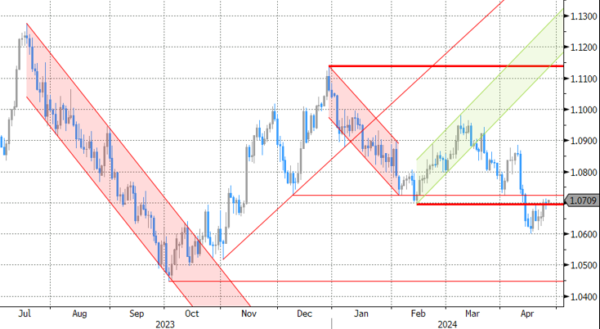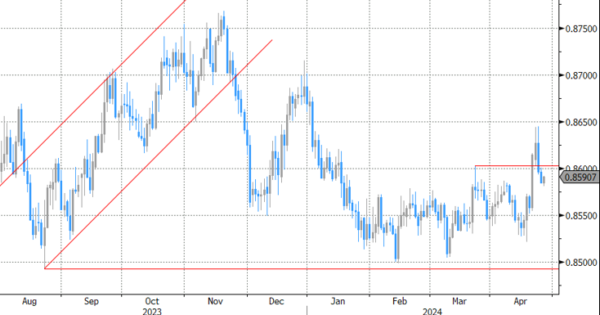Markets
Core bonds drifted away again yesterday. In the US, Treasuries reversed Tuesday’s (disappointing) PMI-induced spike higher. Weakening demand and a slight tail at the US Treasury’s record $70bn 5-yr Note sale kept UST’s near intraday lows going into the close. The longer end of the curve underperformed with the front end locked in the run-up to next week’s FOMC meeting and following a sharp, higher for longer, repositioning since mid-March. We argued before that at least some part of the market/investor community needs to be contemplating a rate hike instead of a cut as the Fed next move to push the US 2-yr yield back above the psychological 5% mark. US yields eventually added up to 4.4 bps for the 30-yr gauge which tested the YTD top at 4.8%. German Bunds extended their (consensus-beating Ifo) underperformance. German yield increased by 4.9 bps (2-yr) to 8.2 bps (30-yr). Unlike in the US, European money markets are still banking on (at least) three 25 bps ECB rate cuts this year. We continue to err on the hawkish side of this prognosis. The German 10-yr yield touched 2.6% for the first time since the end of November of last year. This level coincides with 62% retracement on the Q4 setback in yields. A break higher would be technically significant, opening the path for a full return to 3%. Contrary to Tuesday, EUR/USD failed to profit from the interest rate advantage with the pair closing near unchanged at 1.07. Major US and EMU equity benchmarks closed with minor losses.
Overnight risk sentiment is strongly negatively impacted by a disappointing outlook in Q1 Meta earnings. Nasdaq futures suffer losses of 1.5%. Main Japanese and South Korean bourses record similar losses. The risk environment doesn’t translate into stronger US Treasuries or a dollar, which both trade rather stable. The Japanese yen moved beyond USD/JPY 155 for the first time since 1990 yesterday with the pair currently changing hands at 155.66 in the run-up to tomorrow’s BoJ policy meeting (including new growth and inflation forecasts). We don’t think that any “hawkish” hints on “more” policy normalization down the road will be sufficient to save the ailing currency. It will likely take another hit which could prompt officials to move from verbal to effective interventions. As seen in the (recent) past, such moves often offer only temporary relief without backing from the BoJ.
News & Views
National Bank of Poland (NBP) policymaker Kotecki said that recent softer data is slowly tilting the interest rate debate in Poland toward rate cuts. Kotecki’s base scenario nevertheless remains one where interest rates stay at current level until the end of this year. Recent macro indicators “minimally increase the probability of a rate cut, since it’s clear that the economy isn’t accelerating and is far from overheating”. After touching 2% in March, Kotecki expects inflation to be between 5.5% and 6% at the end of the year as the government scaled back subsidies to mitigated energy bills. In this scenario, the NBP could start discussing mild rate cuts if at the end of the year if inflation data show price growth returning to the NBP’s target ‘for good’ in H2 2025 or in early 2026. After a 1% cumulative rate cuts in September and October last year, the NBP since then kept its policy rate unchanged at 5.75% and indicated that rates were likely to stay on hold as inflation risks persist.
South Korean growth beat expectations by a wide margin this morning. Activity accelerated to 1.3% Q/Q in Q1 2024 (vs 0.6% consensus) from 0.6% in Q4 2023, raising Y/Y growth from 2.2% to 3.4%. Growth in domestic demand was an important driver behind the solid growth performance with private expenditure rising 0.8% Q/Q. Government expenditure (0.7% Q/Q) and construction investment also added to the strong performance. Export growth continued at a solid 0.8% Q/Q. In a sector approach, manufacturing (1.2% Q/Q), construction (4.8% Q/Q) and services (0.7%) all show strong figures. In a first reaction, the Bank of Korea took a cautious approach. It admitted that growth seems to be stronger than int the February forecast and that current data will be incorporated in the new update in May. Still the BoK considers it too early to say if consumption has turned the corner. In March the BoK already acknowledged that there could be upside risk to its 2.1% forecast for this year. The BoK currently holds its policy rate at 3.5%. Stronger data might delay rate cuts that were expected for H2 this year.
Graphs
GE 10y yield
ECB President Lagarde clearly hinted at a summer (June?) rate cut and seems to have broad backing. EMU disinflation will continue the next two months and bring headline CPI (temporary) at/below the 2% target. Together with weak growth momentum, this gives backing to deliver a first 25 bps rate cut. A more bumpy inflation path in H2 2024 and the Fed’s higher for longer strategy make follow-up move difficult.
US 10y yield
The March dot plot contained several hawkish elements including a symbolically higher neutral rate. In our view they set the stage for a later (September at the earliest) start of a possibly shallower cutting cycle. Upcoming CPI readings (through base effects) and resilient eco data should confirm this. US yields continue to enjoy a solid bottom across the maturity spectrum, setting fresh YTD highs.
EUR/USD
Economic divergence (US > EMU) and a likely desynchronized rate cut cycle with the ECB exceptionally taking the lead pulled EUR/USD towards the YTD low at 1.0695. Stronger-than-expected US March inflation figures forced a technical break, opening the path to last year’s low at 1.0494.
EUR/GBP
Debate at the Bank of England is focused at the timing of rate cuts. Most BoE members align with the ECB rather than with Fed view, suggesting that the disinflation process provides a window of opportunity to make policy less restrictive (in the near term). Sterling’s downside turned more vulnerable with the topside of the sideways EUR/GBP 0.8493 – 0.8768 trading range serving as the first real technical reference.


















